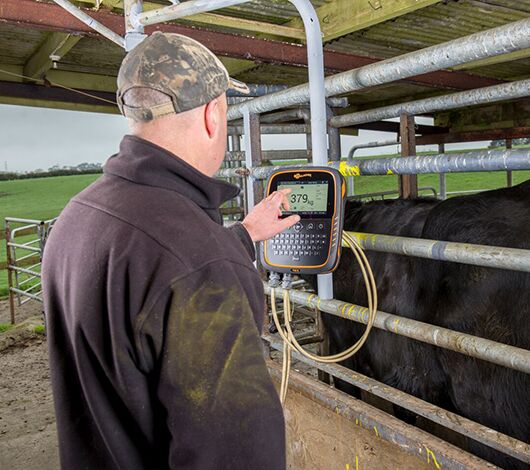Weigh system helps Ontario veal lamb producer manage for success
First-generation farmers Chris and Jen Vervoort know the success of their operation depends on their ability to provide the best care possible for the livestock they manage.
Saturday, 01 January, 2022

First-generation farmers Chris and Jen Vervoort know the success of their operation depends on their ability to provide the best care possible for the livestock they manage.
“Tracking gains can really help to point out some of those minor issues your eye doesn't always pick up on”
To help them achieve this goal, the couple uses a Gallagher livestock weighing and EID (electronic identification) system to track animals' average daily gains.
Vervoort and his wife, who have farmed together for nearly 14 years, got their start in agriculture first by working for other farms. In 2012, they made the leap to managing their own farm with the purchase of their current operation in Arthur, Ontario.
Located about an hour's drive northwest of the bustling metropolis of Toronto, the farm's location is ideal for marketing their grain-fed veal calves, lambs, and beef cattle at auctions and to local processors nearby.
Simmental beef cattle were the first livestock to call the Vervoort farm home. Over time, as cattle markets have become more challenging, Chris has chosen to add veal calves and eventually lamb, to the livestock mix. Unlike beef cattle, these alternative livestock enterprises give Vervoort and his wife opportunities to grow their farm business slowly with minimal investment.
Simmental beef cattle were the first livestock to call the Vervoort farm home. Over time, ascattle markets have become more challenging, Chris has chosen to add veal calves and "There's huge opportunity in veal if you're a good manager," says Vervoort.
According to Vervoort, there are two types of veal production. The first is white-fed veal where calves are raised on a milk-only diet. The second type is grain-fed veal. Grain-fed veal calves only receive milk until 10 weeks of age and afterward are transitioned to a grain ration.
Vervoot's calves are the latter and are raised in group housing in commingled herds of about 50 calves each. He purchases the majority of his calves from local dairies in the region.
"We keep them in a barn with natural ventilation and curtains," says Vervoort. "That's to control the environment so they finish well."
Calves finish at approximately 700 pounds at which point they are destined for the auction barn, and eventually, meat processor. Vervoort notes, ensuring calves finish as close as possible to their final target finishing weight at shipping time is a key factor in raising quality veal.
"Gallagher's TWR-5 Weigh Scale has really helped us get there," says Vervoort. "It allows us to monitor our calves' weights and gains every week quickly and efficiently and keep good records."
Along with raising veal calves, Vervoort says sheep have been a great addition to the farm.
"Raising lambs fit into our lifestyle and program with the veal calves very well," says Vervoort. "The two also complement each other and fall into a similar market and customer demographic."
What started as a trial run with two sheep has now grown into a flock of approximately 400 ewes, says Vervoort. He and his wife raise Dorset and Rideau crossbreds for their breeding females and commonly cross their ewes with Dorset and Suffolk rams. They market their lambs live at auction or direct to a processor similar to their veal calves.
The weigh scale system also comes in useful for monitoring lamb weights, says Vervoort. And when combined with the Gallagher Sheep Auto Drafter, the weighing setup allows him to weigh and sort his lambs with ease.
"Once they've been trained to the system, it works pretty slick," says Vervoort. "It saves us time and eliminates the need for an extra person when sorting and weighing lambs.
Gallagher's weighing and EID systems are also helpful with health data, Vervoort describes, "We use it to do things like search animal records, record when we give medications, and keep track of antibiotic withdrawal times."
Overall, Vervoort believes adding Gallagher's products to his management protocol has greatly helped he and Jen to track their animals' progress, and in turn, make better management decisions. On top of better record-keeping, using regular weighing also helps to give early warning of minor health or nutrition concerns.
"When you look at an animal, you might not necessarily see an issue, but when you look at the numbers on the scale, it easier to see problems," says Vervoort. "Tracking gains can really help to point out some of those minor issues your eye doesn't always pick up on."
For the open-minded producer looking for a weighing and identification system to improve their record-keeping abilities, Vervoort feels Gallagher's weighing and EID system is an ideal choice.
"It's a simple system to use and I really appreciate the fact you can build off of it and add other components easily," says Vervoort. "The sky is really the limit from my perspective. There's so much you can do with it. You just have to dig in and utilize it."
Keep up with happenings at the Vervoort Farm by following Chris on Twitter,@vervoort_chris.
Authored byJesse Bussard, an agricultural writer based in Bozeman, Montana.